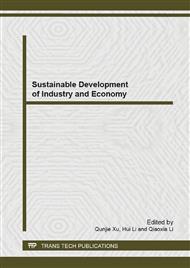[1]
Elsasser,P., Meyerhoff,J., Montagne',C., Stenger,A. A bibliography and database on forest benefit valuation studies from Austria, France, Germany, and Switzerland – A possible base for a concerted European approach [J]. Journal of Forest Economics, 2009, 15: 93-107.
DOI: 10.1016/j.jfe.2008.03.005
Google Scholar
[2]
Fadian Lu, Peichen Gong. Optimal stocking level and final harvest age with stochastic prices[J], Journal of Forest Economics, 2003(9): 119–136.
DOI: 10.1078/1104-6899-00026
Google Scholar
[3]
Graeme Guthrie, Dinesh Kumareswaran. Carbon Subsidies, Taxes and Optimal Forest Management [J]. Environ Resource Economics, 2008, DOI 10. 1007/s10640-008-9238-4.
DOI: 10.1007/s10640-008-9238-4
Google Scholar
[4]
Jean-Daniel Saphores. Harvesting a renewable resource under uncertainty [J], Journal of Economic Dynamics & Control, 2003, 2 (8): 509-529.
DOI: 10.1016/s0165-1889(03)00033-2
Google Scholar
[5]
Jianwu Xiao, Hong Zhai, Chenglin Qin. The Constant Elasticity of Variance (CEV) Model and Legendre Transform-Dual Solution for Annuity Contracts [J], Insurance: Mathematics and Economics, 2007, 3: 302-310.
DOI: 10.1016/j.insmatheco.2006.04.007
Google Scholar
[6]
Jianwu Xiao, Shaohua Yin, Chenglin Qin. The Constant Elasticity of Variance (CEV) Model and The Analytical Strategies for Annuity Contracts [J]. Applied Mathematics and Mechanics, 2006, 27(11): 1499-1506.
DOI: 10.1007/s10483-006-1107-z
Google Scholar
[7]
Katia Rocha, Ajax R.B. Moreira, Eustáquio J. Reis, Leonardo Carvalho. The market value of forest concessions in the Brazilian Amazon: a Real Option approach [J], Forest Policy and Economics, 2006(8): 149– 160.
DOI: 10.1016/j.forpol.2004.05.008
Google Scholar
[8]
Luis H.R. Alvarez, Erkki Koskela. Optimal harvesting under resource stock and price uncertainty [J], Journal of Economic Dynamics & Control, 2007 (31): 2461-2485.
DOI: 10.1016/j.jedc.2006.08.003
Google Scholar
[9]
Margaret Insley. A Real Options Approach to the Valuation of a Forestry Investment [J]. Journal of Environmental Economics and Management, 2002(44): 471 -492.
DOI: 10.1006/jeem.2001.1209
Google Scholar
[10]
Margaret Insley, Kimberly Rollins. On solving the multi rotational timber harvesting problem with stochastic prices: a linear complementarity formulation [J]. American Journal of Agricultural Economics, 2005(8).
DOI: 10.1111/j.1467-8276.2005.00759.x
Google Scholar
[11]
M.C. Insley T.S. Wirjanto. Contrasting two approaches in real options valuation: contingent claims versus dynamic programming, Discussion paper, 2008(3).
DOI: 10.1016/j.jfe.2009.11.002
Google Scholar
[12]
Randall Morck, Eduardo Schwartz, David Stangeland. The Valuation of Forestry Resources under Stochastic Prices and Inventories[J], Journal of Financial and Quantitative Analysis, 1989, 24(4): 473-487.
DOI: 10.2307/2330980
Google Scholar
[13]
Shan Chen, Margaret Insley. Regime switching in stochastic models of commodity prices: An application to an optimal tree harvesting problem. working paper, 2008(8).
DOI: 10.1016/j.jedc.2011.08.010
Google Scholar
[14]
Zuzana Chladná. Determination of optimal rotation period under stochastic wood and carbon prices[J], Forest Policy and Economics, 2007(9): 1031– 1045.
DOI: 10.1016/j.forpol.2006.09.005
Google Scholar


